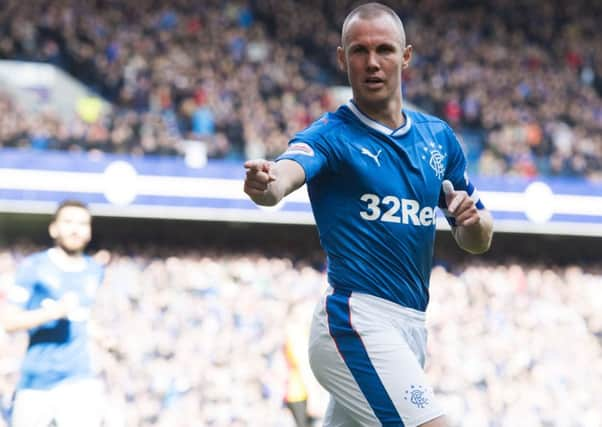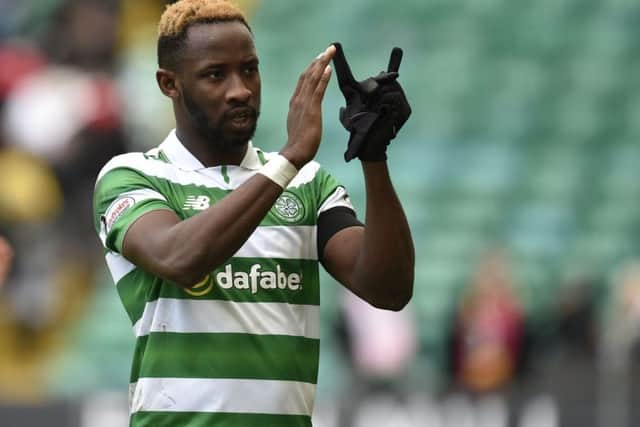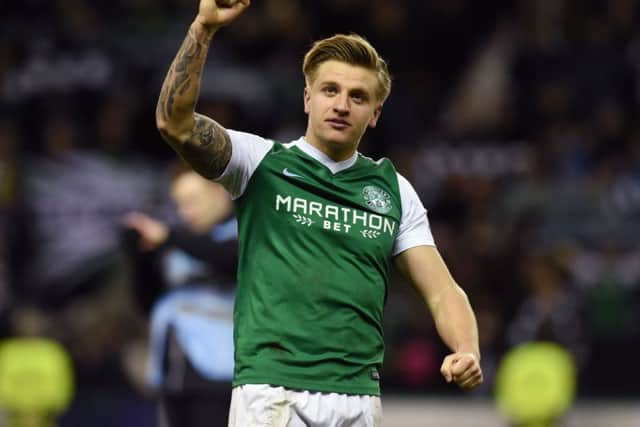The 12 best strikers in Scottish football right now


After Leigh Griffiths sprinted away with the award for best striker in the country last year it was every likelihood that he would be primed to retain the honour. But he faced stiff competition from inside Celtic Park and elsewhere in the Scotland.
One aspect of the list which stands out is just how important many of the strikers are to their team. Goal scorers are so often the difference and it is certainly the case in Scotland.
Advertisement
Hide AdAdvertisement
Hide AdThere is also a wide spread of scoring talents across the league. The players finding the net consistently aren’t all concentrated at the top of the league. Supporters of Hearts and Rangers are likely envious of the options of teams in the lower echelons of the top flight, while two players from the Championship make the cut.
Note: this is a selection of the 12 best overall and not just their form this season.
• Click here to listen to the episode of The Terrace Scottish Football Podcast where the top 12 was debated.


12. Stephen Dobbie (Queen of the South)


There’s an argument to be made that the Palmerston striker deserves to be ahead of Jason Cummings on this list. The two finished as joint-top goalscorers in the Championship last term, though Dobbie did it playing in a severely weaker side, one which would have enjoyed less of the ball and stacked with fewer players capable of creating for the No.9. Also, while Cummings can often play on the periphery of matches, Dobbie imposes himself on games.
The veteran, at age 34, led the second tier in shots on goal, and by some distance. Here was a player who, to drag his team to victory, had to go searching for the play, and drive at his opposition when he had the chance. He was arguably the most valuable player in the second tier, helping Queens to mid-table mediocrity when, without him, a relegation scrap would surely have been a real possibility.
11. Esmael Goncalves (Heart of Midlothian)
The January signing was the biggest success of Hearts’ haphazard recruitment drive. He has not been perfect but shown enough to suggest the club’s outlay will be worthwhile. There have been frustrations among the Hearts support as to what is best position is. He has a fascination with the left flank. When fielded as a central striker he drifts without players filling in the space which he once occupied. While there is a tendency to hold on to the ball for too long.


But there has been sufficient positives. He has the physique to succeed in the division as he demonstrated with his spell at St Mirren. His squat stature allows him to back in to and roll defenders. He is quick and powerful with a good level of skill and, despite his reluctance to operate as a central striker, gets into good scoring positions. Seven was a good return in half a league season but it should have been more. He will likely thrive when played with a focal point.
10. Scott McDonald (Motherwell)
Not only has the Aussie lost out on the crown for Motherwell’s best forward but also the country’s ‘moaniest’ player, yet he is going to be a loss for Well when he departs. Not as significant a loss if he departed last season, his consistency rather than quality dropping this season. However, when he did play the Steelmen were instantly a better team. His presence allowed Louis Moult to concentrate on goalscoring matters and pinning defenders back.
Advertisement
Hide AdAdvertisement
Hide AdMcDonald has made small changes to his game, operating further away from goal but still producing the same outputs he has done throughout his career. He may have dropped in the number of goals he has scored (nine) but his all round play is generally very intelligent, in and out of possession. He can drop into a midfield position if the team are being outnumbered or provided a man-to-man job, like the one he did on Scott Brown. With the ball he is a reliable passer and one of those players who is as comfortable with his back to goal as he is facing goal, adept at turning defenders and opening up play.
9. Jason Cummings (Hibernian)
There is much to look forward to next season and one such intrigue is how well Jason Cummings will get on in the top-flight. He has still not scored in the Premiership, unable to hit the net in 16 appearances in Hibs’ relegation season - albeit he did score twice in the play-off with Hamilton. Since then he has plundered 55 goals in second tier campaigns. He has faced both criticism and doubt, both within and outwith Easter Road but there is no question he is a reliable goalscorer.


Doubt surrounds his all round play. He is not a striker who would be able to forage up front on his own, speaking positively about the effect Grant Holt had on his performances last season doing the gritty side of the game. If he doesn’t score he can, at times, become redundant. But he has made improvements in this sense over the three years in the Championship. He is getting better technically which allows him to contribute more outside the box and become more of a facilitator, but he is never going to be a player to bully defences. Seven goals against Premiership opposition during his stint out the top division does give a sound indication for the season ahead.
8. Kris Doolan (Partick Thistle)
Every season Kris Doolan gets to double figures and, surprise, surprise, the last campaign was no exception. He just always gets there. He may not be lightning quick, he may not be particularly strong or tall, but he’s a player who uses the attributes he has and squeezes all he can out of them. Combining a strong touch with intelligent movement, he curls his runs into the right areas and can finish accurately when presented with a chance, posting the second highest shooting percentage of anyone in the Ladbrokes Premiership last year (behind Steven MacLean).
Every season Partick Thistle bring in a different forward to challenge him, and every time he sees off the competition. The Thistle fans absolutely adore him and, from the loyalty he’s shown to the club through the past few years, it would seem the feeling is more than mutual.
7. Steven MacLean (St Johnstone)
It is quite the feat but 34-year-old is the angriest, ‘moaniest’ and grumpiest player in the league. But he is also one of the best forwards. It is surprising he turns 35 at the start of next season, he seems to be approving with more games, more experience. He is perhaps the most intelligent striker in the league, varying his positioning to suit the demands of Tommy Wright as well as his team-mates. He looks like a traditional number 9, and he can play like one. But he is also adept at dropping into the hole, holding on to the ball, linking play and creating.
His nine league goals have come from only 28 shots. To put that into context Liam Craig took 51 shots, Jamie Walker led the league with 109. He hits the target with 67.57 per cent of his shots, comfortably the best rate in the league. He epitomises St Johnstone: intelligent, hard-working, economical. He is a facilitator and focal point, providing five assists. Replacing his qualities would have been harder than having to replace Danny Swanson.
6. Kenny Miller (Rangers)
Kenny Miller’s productivity at age 37 makes little sense. Some players grow old gracefully. This is usually because, at their peak, they don’t rely on the physical attributes that degenerate more rapidly than the others - speed, strength, stamina etc. Miller’s game was the opposite of that. Throughout his career he’s been known to approach forward play in the manner of a whippet on amphetamine. He tears around the field, constantly moving and playing with a sense of real urgency.
Advertisement
Hide AdAdvertisement
Hide AdObviously, seeing as he used to play in the English Premier League, and now he plays for maybe the worst top-flight Rangers team there’s ever been, his powers have regressed a little. But to give the kind of performances he has this season - honesty, at times he dragged Rangers through games - is something quite special. He’s also able to fill in anywhere across the midfield and not do an utterly horrendous job of it.
5. Adam Rooney (Aberdeen)
An old-fashioned striker if ever there was one. “What does he do?” He scores goals. “Yes, but what else does he do?” Who cares, he scores goals. You could imagine Rooney struggling in a weaker side, one without so much possession and without the abundance of talent which currently surrounds him at Pittodrie. But then he did have such a situation at Inverness CT, and guess what? He scored goals.
There are some predatory strikers who need service, and some who manage to create their own chances without the ability to dribbling beyond defenders. Rooney falls into the latter category. He sniffs out chances in the penalty box. A loose ball here, a deflection there, it doesn’t take much for him to get off a shot at goal. It’s why he continues to be the No.9 at Aberdeen despite the fact that when he’s not on his game, he *really* isn’t on his game.
In matches where Aberdeen may struggle to penetrate, he can often disappear. The game will be ambling along and suddenly he’ll come into view. “Oh aye, Rooney is playing,” you’ll say to yourself. But, just as deceptively, he’ll then latch on to a through pass and bury it beyond the goalkeeper. For a forward who appears to be lumbering at times, he’s got great straight-away speed, and can battle for possession effectively, even if it isn’t as adept at holding the ball up as you may think.
4. Louis Moult (Motherwell)
There is a strong case to be made that without the Englishman, Motherwell would have been relegated. The fact they have two forwards in the list highlights the deficiencies elsewhere in the Well side. But what they have in Moult is a reliable goal scorer, 30 in the league in two seasons. His 15 this campaign earned the Steelmen 10 points - Hamilton his favoured opposition with six against Hamilton Academical. Although he is no flat-track bully with goals against both Celtic and Rangers.
He is a pure forward in Scottish terms, a player every team outside of Celtic would find very useful. He can play with his back to goal, his close control and adroitness at shielding it allows him to bring team-mates up the field before laying it off. He is best with support, however, because he thrives in and around the box. His quick feet are his biggest asset, shuffling the ball quickly to get shots away. He is a danger in the air also, weighing up crosses and sneaking between defenders.
3. Liam Boyce (Ross County)
He’s not particularly fast, he’s not particularly strong and, going purely on aesthetics, he doesn’t look like a footballer. But looks, as we know, can be deceptive, for there are few players in Scottish football who can match the County striker for technique. And even fewer who can match him for goalscoring prowess.
While he may not have reached the top of the goalscorers charts if Moussa Dembele hadn’t been injured, or Leigh Griffiths hadn’t sat on the bench for much of the season, it’s an incredible feat for a player on a struggling side, especially when you consider he played for the first three months of 2017 in midfield (why Jim McIntyre, why?). Assistant boss Billy Dodds recently slapped a £1m price tag on the player and it’s easy to see why.
2. Leigh Griffiths (Celtic)
Advertisement
Hide AdAdvertisement
Hide AdIt has been a strange old season for Griffiths. He came into the campaign as Celtic’s first choice striker following a 40-goal season before missing the 5-1 defeat of Rangers through injury allowing Moussa Dembele to firmly announce himself as Celtic’s star forward. From that moment it was a stop-start season for the Scotland striker. But when he has been called upon he hasn’t disappointed. He has been the most efficient forward in the league, netting 12 goals and laying on six more despite making only 15 starts.
There may be an argument that he has regressed this season but that would be nonsensical. Last season he was so dominant. This season, he has a higher player of quality around him who are also seizing their moment in attack and Griffiths is not quite as omnipresent. He still offers the quality on the shoulder of the defender, the rasping shot, the goals, the first touch which allows him to take shots early, catch goalkeepers cold. This was evident in the second 5-1 Old Firm win. He may have had a strop with Rodgers but there is no question he will become a more rounded striker under the Northern Irishman’s management. Plus, in the Labrokes Premiership, he scores goals.
1. Moussa Dembele (Celtic)
Beating out Griffiths is the striker that, apparently, all of Europe wants to sign. The Frenchman always looked like being a terrific purchase when Celtic managed to wriggle him free of Fulham’s grasp for a paltry £500,000 compensation fee, but surely nobody expected the rapid rise he’s enjoyed to this point. And the weird thing is, it could have been better. He suffered a pair of injuries that derailed the season half of his season. Can we imagine what kind of ridiculous goalscoring numbers he could put up if he’s able to stay injury free for next year’s campaign?
What Dembele has over Griffiths is an advantage that forwards simply require in the modern day, where most team’s play with one centre forward, and that’s the ability to hold the ball in attack. To do so effectively at any level, a forward needs size (tick), strength (tick), good technique (tick), and, if possible, a little speed and trickery to make things happen when the cavalry doesn’t arrive (tick, tick). Griffiths can do this in the SPFL, where he’s massively improved his lone-striker play since signing for Celtic, but Dembele can do it on the continent.